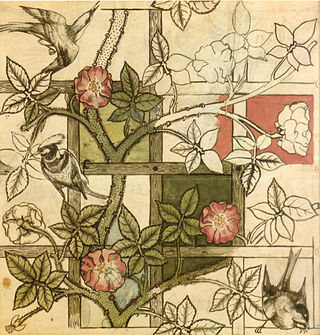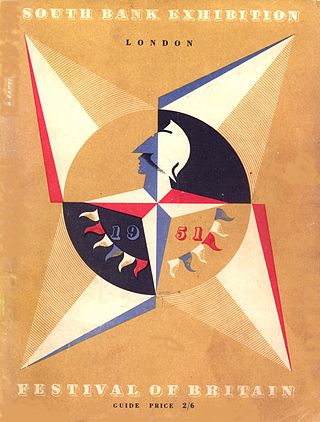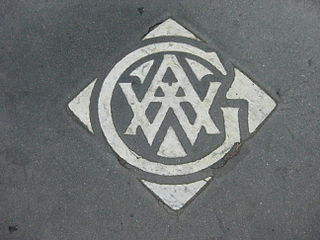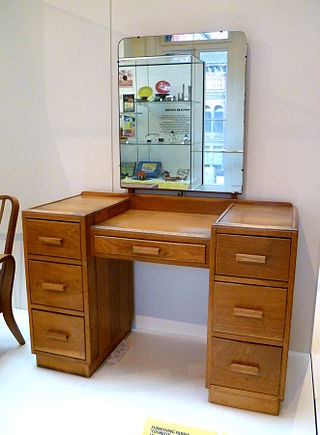
The Arts and Crafts movement was an international trend in the decorative and fine arts that developed earliest and most fully in the British Isles and subsequently spread across the British Empire and to the rest of Europe and America.

The Festival of Britain was a national exhibition and fair that reached millions of visitors throughout the United Kingdom in the summer of 1951.

The Art Workers' Guild is an organisation established in 1884 by a group of British painters, sculptors, architects, and designers associated with the ideas of William Morris and the Arts and Crafts movement. The guild promoted the 'unity of all the arts', denying the distinction between fine and applied art. It opposed the professionalisation of architecture – which was promoted by the Royal Institute of British Architects at this time – in the belief that this would inhibit design. In his 1998 book, Introduction to Victorian Style, University of Brighton's David Crowley stated the guild was "the conscientious core of the Arts and Crafts Movement".

Misha Black was a British-Azerbaijani architect and designer. In 1933 he founded with associates in London the organisation that became the Artists' International Association. In 1943, with Milner Gray and Herbert Read, Black founded Design Research Unit, a London-based Architectural, Graphic Design and Interior Design Company.

Henry Duncan McLaren, 2nd Baron Aberconway, was a British politician, horticulturalist and industrialist. He was the son of Charles McLaren, 1st Baron Aberconway and Laura Pochin.

Founded as the Brighton School of Art in 1859, the University of Brighton School of Art and Media is an organisational part of the University of Brighton, with courses in the creative arts, visual communication, media, craft and fashion and textile design.

Heal's is a British furniture and homeware retail company comprising seven stores, selling a range of furniture, lighting and home accessories. The business was started in 1810 by John Harris Heal and his son, and it's flagship store has been located in Tottenham Court Road since 1818. Under Sir Ambrose Heal, the company introduced Arts and Craft style to mechanised furniture production, making it available to the middle classes. In 2001, a guide published in association with the Victoria & Albert Museum wrote that for over two centuries Heal's had been known for promoting modern design and for employing talented young designers. Since 2001, the business has been owned by Wittington Investments, a company owned by the Weston family.
Sir Ambrose Heal was an English furniture designer and businessman in the first half of the 20th century. He served as the chairman of Heal's from 1913 to 1953.

Marianne Straub OBE was one of the leading commercial designers of textiles in Britain in the period from the 1940s to 1960s. She said her overriding aim was: "to design things which people could afford. ... To remain a handweaver did not seem satisfactory in this age of mass-production".

Désirée Lucienne Lisbeth Dulcie Day OBE RDI FCSD was one of the most influential British textile designers of the 1950s and 1960s. Day drew on inspiration from other arts to develop a new style of abstract pattern-making in post-war British textiles, known as ‘Contemporary’ design. She was also active in other fields, such as wallpapers, ceramics and carpets.

The city of Glasgow, Scotland is particularly noted for its 19th-century Victorian architecture, and the early-20th-century "Glasgow Style", as developed by Charles Rennie Mackintosh.
Frederick Henri Kay Henrion, RDI, OBE, was a Nuremberg-born German graphic designer.
Milner Connorton Gray CBE (1899–1997) was one of the key figures of British industrial design in the 20th century, having played an important role in establishing design as a recognized profession, the emergence of British design consultancies, and the development of Design Management.

Britain Can Make It was an exhibition of industrial and product design held at the Victoria and Albert Museum in London in 1946. It was organised by the Council of Industrial Design, later to become the Design Council.
The University of Brighton Design Archives centres on British and global design organisations of the twentieth century. It is located within the University of Brighton Grand Parade campus in the heart of Brighton and is an international research resource. It has many archival collections that were generated by design institutions and individual designers
The College of Medallists is an association of recipients of The Sir Misha Black Medal for Distinguished Services in Design Education. Misha Black (1910–1977) was a pioneer of design in Britain. The College of Medallists was established in 2000, and joined the Founding Bodies in supporting the Sir Misha Black Awards. In 2020, the College of Medallists became part of the Royal Commission for the Exhibition of 1851, with the Imperial College of London as a founding body.

The Sir Misha Black Awards commemorate the life of Misha Black, whose work played an important role in the development of design in Britain. They are given to individuals and institutions to honor them in their role within design education.
Harry Hardy Peach was an English businessman and author involved in campaigning for improved conditions in factories and the establishment of the Design and Industries Association and the Council for the Preservation of Rural England.

James "Leslie" Gardner OBE RDI was a British museum and exhibition designer. Although most widely known for his exhibition work, Gardner also undertook illustration and ship design work. His archive is located at the University of Brighton Design Archives.
Jacqueline Groag was an influential textile designer in Great Britain in the period following World War II. She produced and designed fabrics for leading Parisian fashion houses including Chanel, Lanvin, House of Worth, Schiaparelli and Paul Poiret.
"Nothing Need Be Ugly", The first 70 years of the Design & Industries Association. Plumber, Raymond. DIA London 1985












